Documents: Go to download!
User Manual
- User Manual - (English)
- Quick Start Guide - (English)
- Getting to Know Your Display
- Using the On-Screen Menu
- HELP TOPICS
Table of contents
User Guide Television
Getting to Know Your Display

The power indicator flashes on when the Display turns on, then goes out after several seconds.
To keep the power indicator on as long as the Display is on, see Turning the Power Indicator On or Off.
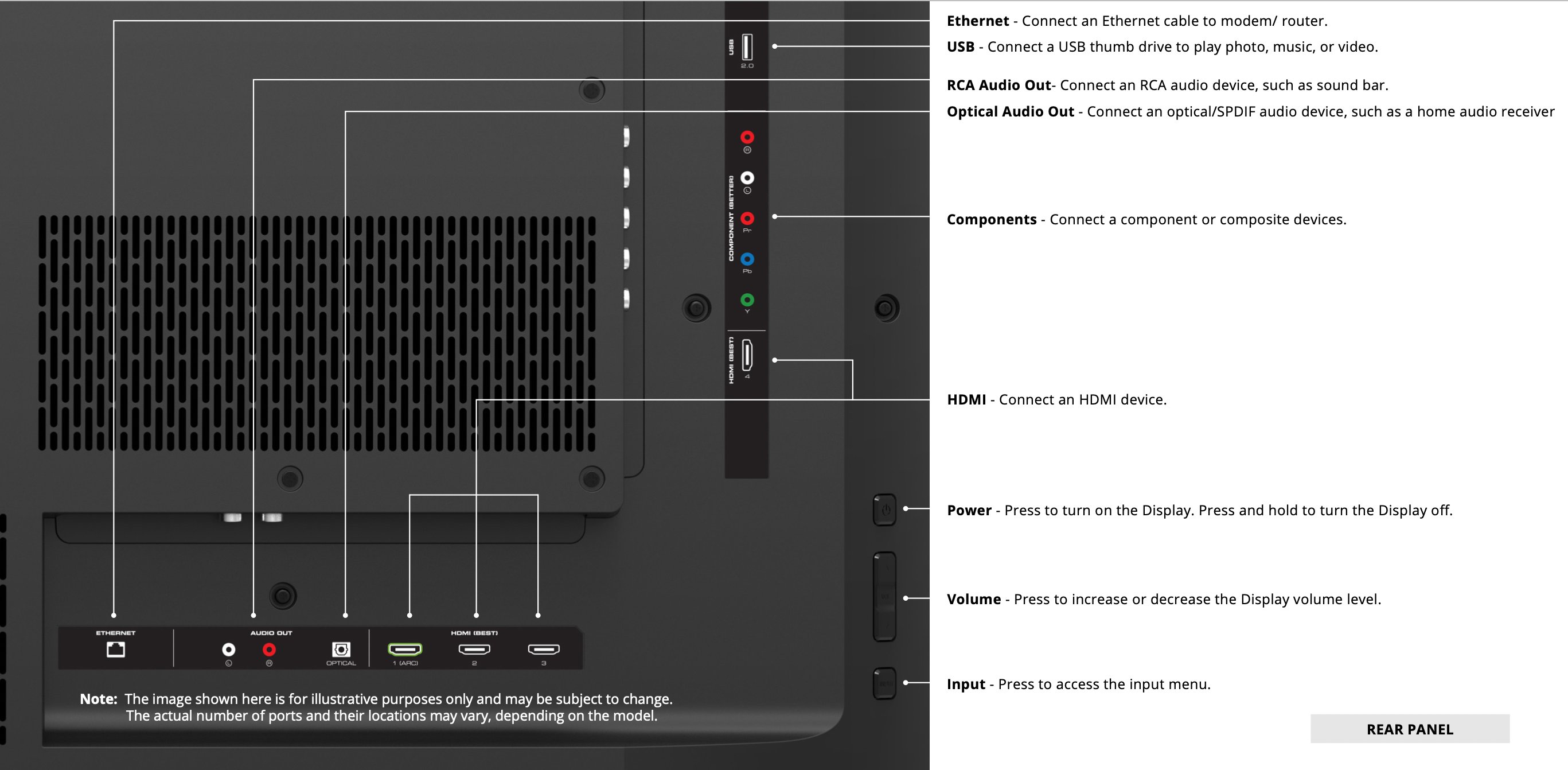
WALL-MOUNTING THE DISPLAY
To mount your Display on a wall, you will need a wall mount. Consult the information on this page to find the appropriate mount for your Display.
Be sure the mount you choose is capable of supporting the weight of the Display. After you have determined that you have the correct mount for your Display, you can begin the installation.
To install your Display on a wall:
- Disconnect any cables connected to your Display.
- Place the Display face-down on a clean, flat, stable surface. Be sure the surface is clear of debris that can scratch or damage the Display.
- Remove the stands by loosening and removing the screws.
- Attach your Display and wall mount to the wall, carefully following the instructions that came with your mount. Use only with a UL-listed wall mount bracket rated for the weight/load of this Display.
TIP: Installing a Display on a wall requires lifting. To prevent injury or damage to the Display, ask someone to help you.

USING THE REMOTE

- Power - Turn TV on or off.
- Input - Change the currently displayed input.
- Quick Access to popular apps
- Exit - Close the on-screen menu.
- Menu - Display the on-screen menu.
- Arrows - Navigate the on-screen menu.
- OK / Enter - Select the highlighted option / Confirm channel or passcode entered using the number pad.
- Back - Go to the previous on-screen menu.
- Info - Display the info window.
- Volume Up/Down - Increase or decrease the loudness of the audio.
- Closed Captions - Open the closed caption menu.
- VIZIO Button - Launch SmartCast TV
- PIC - NOT SUPPORTED ON THIS MODEL.
- Channel Up/Down - NOT SUPPORTED ON THIS MODEL.
- Mute - Turn the audio on or off.
- Last - NOT SUPPORTED ON THIS MODEL.
- Number Pad - NOT SUPPORTED ON THIS MODEL.
- Link - NOT SUPPORTED ON THIS MODEL.
- Dash - NOT SUPPORTED ON THIS MODEL.
Replacing the Batteries
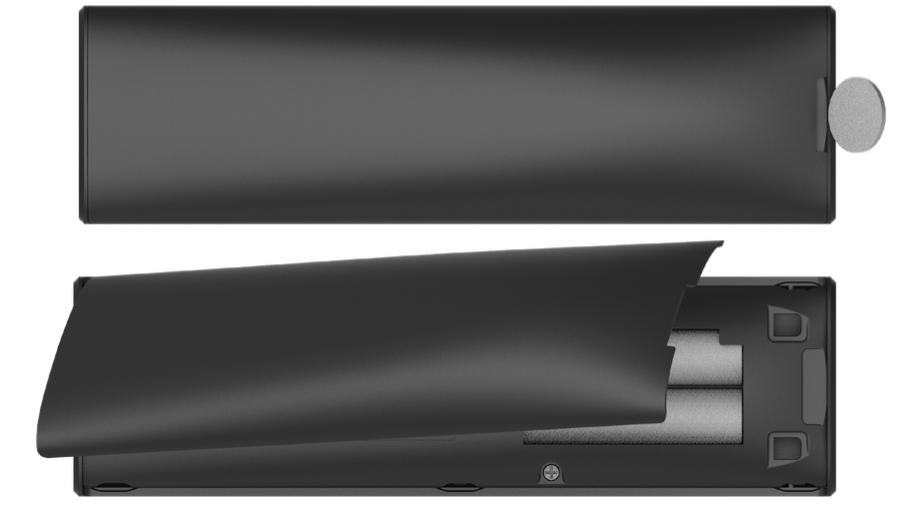
- Remove the battery cover by pressing down on the arrow markings and sliding out.
- Insert two batteries into the remote control. Make sure that the (+) and (-) symbols on the batteries match the (+) and (-) symbols inside the battery compartment.
- Replace the battery cover.
WARNING: Keep the remote control batteries away from children. It may cause choking and/or lead to a fire or chemical burn if mishandled. Do not dispose of batteries in fire. Replace only with batteries of the correct type.
Tip: When needed, VIZIO recommends replacing the batteries that came with this remote with two, new Duracell ‘AAA’ alkaline batteries.
Using the On-Screen Menu
Your Display features an easy-to-use on-screen Menu.
To open the on-screen Menu, press the Menu button on the remote.
To open the on-screen Menu, press the Menu button on the remote.
From this Menu, you can:

- Adjust the Picture settings
- Adjust the Audio settings
- Adjust the Network settings
- Setting the Sleep Timers
- Name and adjust Inputs
- Open Closed Caption Menu
- Adjust System settings
- Access the user manual
NAVIGATING THE ON-SCREEN MENU

Tip: While navigating the on-screen Menu, you can press the Back button at any time to return to the previous Menu screen. The Exit button will close the onscreen Menu.
CHANGING THE INPUT SOURCE
External devices such as DVD players, Blu-ray Players, and video game consoles can be connected to your Display. To use one of these devices with your Display, you must first change the Input source using the Input Menu.
To change the Input source:
- Press the Input button on the remote. The Input Menu is displayed.
- Use the Left/Right Arrow buttons or the Input button on the remote to highlight the Input you wish to view and press OK. The selected Input is displayed.

Tip: You can change Note: Inputs themay Input vary by names Display. that appear on the Input Menu to make your devices easy to recognize. See Renaming Devices on the Input Menu for more information.
CHANGING THE SCREEN ASPECT RATIO
The Display can display images in five different modes: Normal, Stretch, Panoramic, Wide, and Zoom. Each mode displays the picture differently.
Some programs have black bars on the top or sides of the picture so that the picture keeps its original shape. Examples include wide-screen movies and older television programs.
To change the screen aspect ratio:
- Press the WIDE button on the remote.
- Use the Arrow buttons to highlight the aspect ratio you wish to view and press OK.
- Normal preserves the content’s original aspect ratio and size.
- Standard Definition (480i and 480p—old Display programs) - Since the 4:3 aspect ratio is not large enough to fill the Display’s screen, black bars are added to the left and right of the display image.
- 720p HD - Fills a 720p screen.
- 1080p and 1080i HD - Fills a 1080p or 1080i screen.
- Stretch expands a widescreen image to fill the screen from top to bottom and stretches it half as much from right to left. Figures appear tall and thin.
- Standard Definition - Not available.
- 720p HD - If you are watching widescreen 1.85:1 content, the image will fill the screen. With 2.35:1 widescreen content, one-sixth of the image is cut off by the left and right sides of the screen.
- 1080p and 1080i - Not available.
- Panoramic stretches a 4:3 aspect ratio picture to the left and right edges of the screen. The center of the image is not stretched, but the sides of the image are extremely stretched. If you are watching widescreen (1.85:1 or 2.35:1) content with black bars on the top and bottom, the black bars will still appear on the top and bottom of the display image.
- Standard Definition (480i and 480p) - Fills the screen from the left to right edges.
- 720p - Not available.
- 1080p and 1080i - Not available.
- Wide stretches a 4:3 aspect ratio picture to the edges of the screen. Since the picture is being stretched, the display image may appear distorted—figures appear short and fat. If the program is already formatted for widescreen viewing (1.85:1 or 2.35:1), then black bars will appear on the top and bottom of the display image.
- Zoom expands images evenly in all directions (33% taller and 33% wider) with black bars to fit the screen. A 720p image will fill a 1080p screen.
- Standard Definition - Not available.
- 720p HD - Fills a 720p screen
- 1080p and 1080i - Not available.
Tip: The aspect ratio cannot be changed for Ultra HD content.
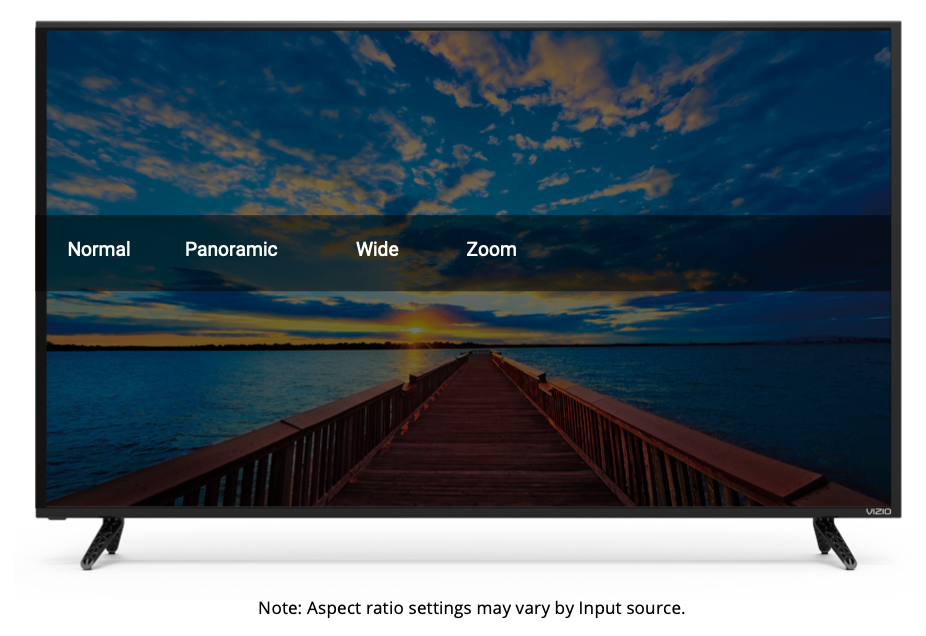
ADJUSTING THE PICTURE SETTINGS
Your Display display can be adjusted to suit your preferences and viewing conditions.
Tip: If you’ve changes to the settings for a picture mode, an asterisks appears after its name (see Saving a Custom Picture Mode).
To adjust the picture settings:
- Press the Menu button on the remote. The on-screen Menu is displayed.
- Use the Arrow buttons on the remote to highlight Picture and press OK. The PICTURE Menu is displayed.
- Use the Arrow buttons on the remote to highlight Picture Mode, then use the Left/Right Arrow buttons to change the picture mode:
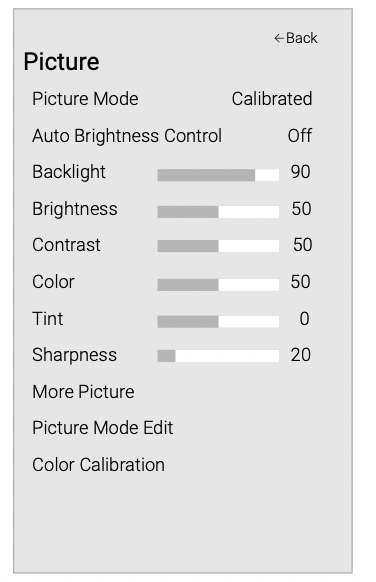
Standard mode sets the picture settings to the default settings.
Calibrated mode sets the picture settings to values ideal for watching Display in a brightly-lit room.
Calibrated Dark mode sets the picture settings to values ideal for watching Display in a dark room.
Vivid mode sets the picture settings to values that produce a brighter, more vivid picture.
See other models: E50-C1 E48-D0 E50-E1 E500i-B1E E50u-D2
Game mode reduces throughput delays and optimizes the picture settings for displaying game console output.
Computer mode optimizes the picture settings for displaying computer output. - To manually change each of the picture settings, use the Up/ Down Arrow buttons on the remote to highlight that picture setting, then use the Left/Right Arrow buttons to adjust the setting:
Auto Brightness Control - The auto brightness control detects the light levels in the room and automatically adjusts the Backlight for the best picture. Select Off, Low, Medium, or High.
Backlight - Adjusts the LED brightness to affect the overall brilliance of the picture. Backlight cannot be adjusted when starting from some picture modes.
Brightness - Adjusts the black level of the picture. When this setting is too low, the picture may be too dark to distinguish details. When this setting is too high, the picture may appear faded or washed out.
Contrast - Adjusts the white level of the picture. When this setting is too low, the picture may appear dark. When this setting is too high, the picture may appear faded or washed out. If the setting is too high or too low, detail may be diɝcult to distinguish in dark or bright areas of the picture.
Color - Adjusts the intensity of the picture colors.
Tint - Adjusts the hue of the picture. This setting is useful in adjusting the flesh tones in the picture. If flesh appears too orange, reduce the level of color before adjusting tint.
Sharpness - Adjusts the edge sharpness of picture elements.
It can be used to sharpen non-HD (high definition) content; however, it will not produce detail that does not otherwise exist. - When you have finished adjusting the picture settings, press the Exit button on the remote.
Adjusting More Picture Settings
To adjust more picture settings:
- From the PICTURE Menu, use the Arrow buttons to highlight More Picture, and then press OK.
- Use the Arrow buttons to highlight the setting you wish to adjust, then press the Left/Right Arrow buttons to change the setting:

Color Temperature - See Adjusting the Color Temperature.
Black Detail - Adjusts the average brightness of the picture to compensate for large areas of brightness. Select Off, Low, Medium, or High.
Active LED Zones - Dynamically improves the contrast ratio of the picture by adjusting the Backlight. The adjustment is controlled by the content on the screen. Select On or Off.
Motion Control - Adjusts motion related features (not on all models)
Reduce Judder - Activates Smooth Motion motion estimation/motion compensation, which suppresses motion judder, or “stuttering” of the image when the camera moves across a scene horizontally. As the setting increases, judder is reduced.
Reduce Motion Blur - Increases frame rate to reduce motion blur of 60 hertz video. As the setting increases, motion blur is reduced.
Clear Action - Reduces blue in scenes with fast action.Some sensitive viewers may notice flickering. Select On or Off.
Reduce Signal Noise - Diminishes artifacts in the image caused by the digitizing of image motion content. Select Off, Low, Medium, or High.
Reduce Block Noise - Reduces pixelation and distortion for mpeg files. Select Off, Low, Medium, or High.
Game Low Latency - Select On to reduce video delay (lag) when gaming.
Pure Cinema Mode - Optimizes the picture for watching film. Select Auto or Off.
Color Space ‡ - Select Color Space for the source. Video sources uses YCbCr, but PC uses RGB.
Gamma - Set the shape of the Gamma curve. Use lower Gamma values for bright room conditions, and higher values when it’s dark. - When you have finished adjusting More Picture Settings, press the Exit button on the remote.
Adjusting the Color Temperature
Adjusting the color temperature changes the white balance of the picture.
To adjust the color temperature:
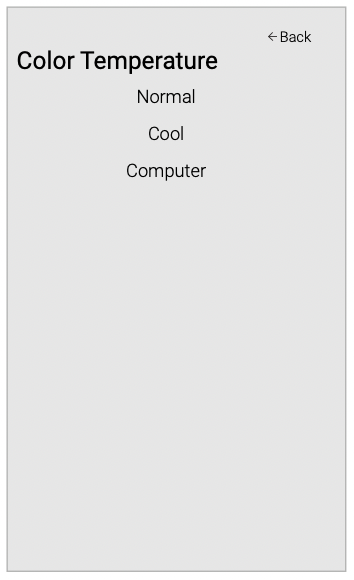
- From the MORE PICTURE Menu, use the Arrow buttons to highlight Color Temperature, and then press OK.
- Use the Arrow buttons on the remote to highlight a color temperature preset and then press OK.
Normal is optimized for television viewing.
Cool produces a blue-hued picture.
Computer optimizes the picture for use as a PC monitor.
When you have finished adjusting the color temperature, press the Exit button on the remote.
Adjusting the Picture Mode Edit Settings
Picture Mode Edit Settings allow you to make precise adjustments to the picture and to create picture modes to save groups of picture settings.
To adjust the Picture Mode Edit settings:
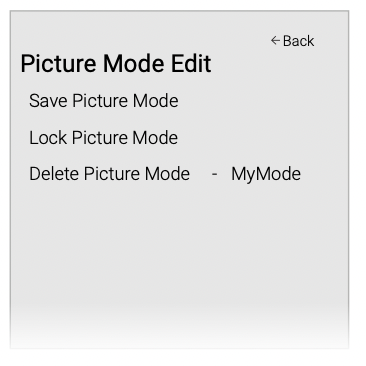
- From the PICTURE Menu, use the Arrow buttons to highlight Picture Mode Edit, and then press OK. The PICTURE MODE EDIT Menu is displayed.
- Use the Arrow buttons to highlight the setting you wish to adjust, then press OK to change the setting:
Save Picture Mode - Save a custom picture mode.
Lock Picture Mode - Prevent changes to custom picture modes. Choose between On or Off

Delete Picture Mode †- Delete a saved picture mode settings.
Saving a Custom Picture Mode
Custom picture modes allow you to save a group of custom settings for various viewing conditions and video sources.
- Changes made while on any preset picture mode will add an asterisk on the top right corner of the preset mode.
- The custom picture mode is not automatically saved.
To save a custom picture mode:

- From the PICTURE MODE EDIT Menu, use the Arrow buttons to highlight Save Picture Mode, and then press OK. The SAVE PICTURE MODE Menu is displayed.
- Use either on-screen keyboard to enter a name for your custom picture mode.
- Highlight Save and press OK.
- Press the Exit button to Exit the Menu screens.
Locking/Unlocking a Custom Picture Mode
Custom picture modes can be locked/unlocked with a systemn PIN to prevent accidental changes to their settings.
To lock all custom picture modes:
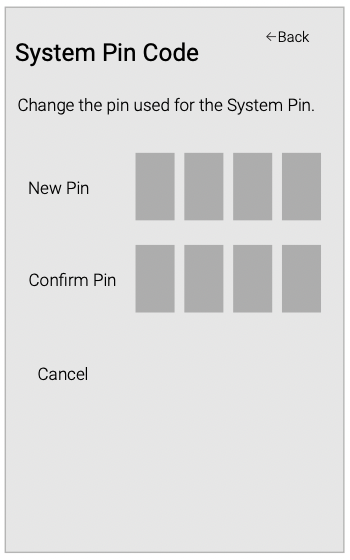
- From the PICTURE MODE EDIT Menu, use the Arrow buttons to highlight Lock Picture Mode, and then press OK. The LOCK PICTURE MODE Menu is displayed.
- Use the Arrow buttons to select On.
- Use the Number Pad on your remote to enter a unique 4-digit PIN.
—or—
If a system pin code was previously created, use the Number Pad on your remote to enter your pin code.
To unlock all custom picture modes:
- From the PICTURE MODE EDIT Menu, use the Arrow buttons to highlight Lock Picture Mode, and then press OK. The UNLOCK PICTURE MODE Menu is displayed.
- Use the Arrow buttons to select Off.
- Use the Number Pad on your remote to enter your 4-digit PIN.
- Make any desired changes to the picture modes.
- Relock the picture modes, if desired.
- Press the Exit button to Exit the Menu screens.
Deleting a Custom Picture Mode
Custom picture modes that are no longer needed can be deleted.
Inputs assigned to a deleted custom picture mode become assigned to the Calibrated picture mode.
To delete a custom picture mode:
- From the PICTURE MODE EDIT Menu, use the Arrow buttons to highlight Delete Picture Mode, and then press OK. The DELETE PICTURE MODE window is displayed.
- Use the Left/Right Arrow buttons to highlight Delete and press OK.
- Press the Exit button to Exit the Menu screens.

Resetting a Picture Mode
A preset picture mode that has been edited can be restored to the factory default settings.
To reset a customized preset picture mode:
- From the PICTURE MODE EDIT Menu, use the Arrow buttons to highlight Reset Picture Mode, and then press OK. The RESET PICTURE MODE window is displayed.
- Use the Left/Right Arrow buttons to highlight Reset and press OK.
- Press the Exit button to Exit the Menu screens.

Adjusting the Color Tuner Settings
The Color Tuner settings allow you to adjust the HSB color and 11 point white balance, turn color channels off for testing, and display color bar, flat, and ramp test patterns.
WARNING: The Color Tuner, 11 Point White Balance, and test patterns allow technicians to manually calibrate the Display. Calibration requires specialized training, an Input with precisely set colors, and a specialized light meter.
To adjust the HSB color settings:
- From the COLOR CALIBRATION Menu, use the Arrow buttons to highlight Color Tuner, and then press OK. The Color Tuner Menu is displayed.
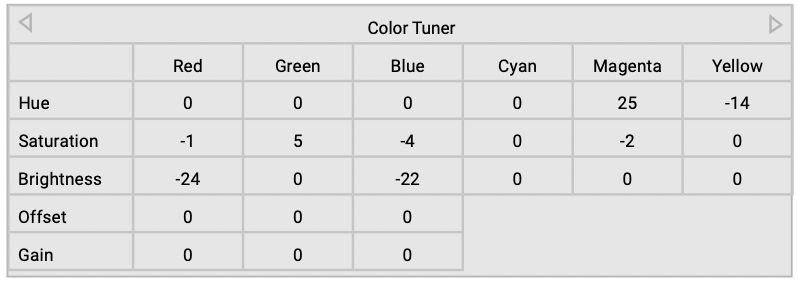
- Use the Arrow buttons on the remote to highlight the Hue, Saturation, Brightness, Offset, or Gain of the color you wish to adjust. Press the OK button.
- Use the Left/Right Arrow buttons to adjust the value. When you are finished press the OK button to save the setting.
- When you are finished adjusting the color tuner settings, press the Exit button.
To turn color channels off and on:
- From the COLOR CALIBRATION Menu, use the Arrow buttons to highlight Color Tuner, and then press OK. The Color Tuner Menu is displayed.

- Use the Arrow buttons on the remote to highlight Red, Green, or Blue.
- Press the OK button to turn the color channel off or on. An X appears over a color channel that has been turned off.
- Use the Arrow buttons to highlight another color channel to turn off or on. Only two color channels can be turned off at the same time.
- When you are finished with the color channels, press the Exit button.
To adjust the 11 Point White Balance settings:
- From the Color Tuner Menu, use the Arrow buttons to highlight Color Tuner, and then press the Left/Right Arrow buttons until the 11 Point White Balance Menu is displayed.

- Use the Arrow buttons on the remote to highlight the Gain and Color values you wish to adjust. Press the OK button and use the Left/Right Arrow buttons to adjust the value. When you are finished, press the OK button to save the setting.
- When you are finished, press the Exit button.
To show or hide the SMPTE Test Pattern:
- From the Color Tuner Menu, use the Arrow buttons to highlight Color Tuner, and then press the Left/Right Arrow buttons until the SMPTE TEST PATTERN Menu is displayed.

- Use the Arrow buttons on the remote to highlight Off. Use the Left/Right Arrow buttons to highlight On to show the SMPTE Pattern.
—or—
To hide the SMPTE Test Pattern, use the Left/Right Arrow buttons to highlight Off. - When you are finished, press the Exit button.
To show or hide the Flat Test Pattern:
- From the Color Tuner Menu, use the Arrow buttons to highlight Color Tuner, and then press the Left/Right Arrow buttons until the Menu is displayed.

- Use the Arrow buttons on the remote to highlight Off. Use the Left/Right Arrow buttons to select the percentage brightness for the flat test pattern. Selecting a percentage immediately shows the flat pattern at that brightness.
—or—
To disable the Flat Test Pattern, use the Left/Right Arrow buttons to highlight Off. - When you are finished, press the Exit button.
To show or hide the Ramp Test Pattern:
- From the Color Tuner Menu, use the Arrow buttons to highlight Color Tuner, and then press the Left/Right Arrow buttons until the RAMP TEST PATTERN Menu is displayed.

- Use the Arrow buttons on the remote to highlight Off. Use the Left/Right Arrow buttons to select the color for the ramp test pattern. Selecting a color immediately shows that color ramp.
—or—
To hide the Ramp Test Pattern, use the Left/Right Arrow buttons to highlight Off. - When you are finished, press the Exit button.
To show or hide the Uniformity Analyzer Test Pattern:
- From the Color Tuner Menu, use the Arrow buttons to highlight Color Tuner, and then press the Left/Right Arrow buttons until the UNIFORMITY ANALYZER TEST PATTTERN Menu is displayed.

- Use the Arrow buttons on the remote to highlight Off. Use the Left/Right Arrow buttons to highlight On to show the Uniformity Analyzer Test Pattern.
—or—
To hide the Uniformity Analyzer Test Pattern, use the Left/Right Arrow buttons to highlight Off. - When you are finished, press the Exit button.
ADJUSTING THE AUDIO SETTINGS
To adjust the audio settings:

- Press the Menu button on the remote. The on-screen Menu is displayed.
- Use the Arrow buttons on the remote to highlight Audio and press OK. The AUDIO Menu is displayed.
- Use the Arrow buttons to highlight the setting you wish to adjust, then press Left/ Right Arrow buttons to change the setting:
Speakers - Turns the built-in speakers On or Off.
Volume Control Display - Toggle between On or Off to hide or display the on-screen volume slider that appears when volume is adjusted.
Tip: When the Display speakers are set to On, DTS signals cannot be passed through digital audio outputs.
Surround Sound - Surround sound uses DTS TruSurround™ to deliver an immersive surround sound experience from the Display’s internal speakers. TruSurround completes the entertainment experience by providing deep, rich bass and by delivering crisp details and clear, intelligible dialog. Select On or Off.
Volume Leveling - Volume leveling uses DTS TruVolume ™ to maintain consistent volume levels during transitions between program content, AV formats, and Input sources. Select On or Off. In a few cases, volume leveling may artificially suppress volume increases, making it diɝcult to hear dialog or flattening sudden noises. If this occurs, turn volume leveling off.
Balance - Adjusts the loudness of the audio output from the left and right speakers.
Lip Sync - Adjusts the synchronization between the display image and the accompanying audio track.
Digital Audio Out - Changes the type of processing for digital audio out and HDMI ARC output when connected to a home theater audio system. Select Auto, PCM, Dolby D, or Bitstream.
Tip: You must select Bitstream for audio with more than two channels (3.0, 5.0, or 5.1, for example).
Analog Audio Out - Sets the volume control properties for the RCA connector when connected to a home theater audio system. Select Variable if you are controlling the volume with the Display’s volume controls, or select Fixed if an external audio device (sound bar or AV receiver) will control the volume.
Equalizer - Adjusts the boost or attenuation of different frequencies using either preset or custom settings. See Changing the Equalizer Settings. - When you have finished adjusting the audio settings, press the Exit button on the remote.
Changing the Equalizer Settings
The graphic equalizer has several pre-set modes and allows you to create one custom mode.
To select a pre-set audio mode:
- Press the Menu button on the remote. The on-screen Menu is displayed.
- Use the Arrow buttons on the remote to highlight Audio and press OK. The AUDIO Menu is displayed.
- Use the Arrow buttons to highlight Equalizer and press OK.
The Audio Mode and equalizer settings screen appears. - Use the Left and Right Arrow buttons to select an audio mode.
The equalizer bars change to reflect the mode. - Press the Exit button on the remote.
To create, modify, or replace the single custom equalizer setting:
- Press the Menu button on the remote. The on-screen Menu is displayed.
- Use the Arrow buttons on the remote to highlight Audio and press OK. The AUDIO Menu is displayed.
- Use the Arrow buttons to highlight Equalizer and press OK.
The Audio Mode and equalizer settings screen appears. - Use the Left and Right Arrow buttons to select any audio mode as a starting point.
- Use the Arrow buttons to highlight a frequency and then press OK.
- Use the Up and Down Arrow buttons to adjust the boost (up) and attenuation (down) for the frequency.
- Use the Left and Right Arrow buttons to select another frequency, if desired, and adjust it.
- Press the Exit button on the remote.
ADJUSTING THE NETWORK SETTINGS
Your Display is Internet-ready, featuring both an Ethernet port and built-in high-speed Wireless-N.
Tip: If your Display is connected to a network with an Ethernat cable, you will not see the wireless network connection Menu. You must decide the Ethernet cable to set a wireless network connection.
Connecting to a Wireless Network
To connect to a wireless network whose network name (SSID) is being broadcast:
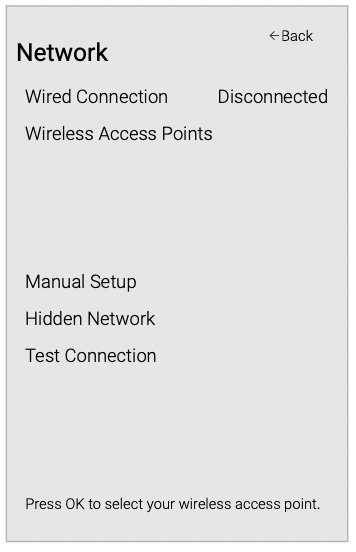
- Press the Menu button on the remote. The on-screen Menu is displayed.
- Use the Arrow buttons on the remote to highlight Network and press OK. The NETWORK Menu is displayed.
- If you do not see your wireless network displayed, highlight More Access Points and press OK. The WIRELESS ACCESS POINTS Menu, which is a list of available wireless networks, is displayed.
- Highlight the name of your wireless network (this is the network’s SSID) and press OK.
- Using the on-screeen keyboard, enter your network’s password, then highlight Connect and press OK.
- Press the Exit button on the remote.
Changing the Manual Setup Settings
Advanced users can fine-tune the network settings using the Manual Setup feature.
To change advanced network settings:
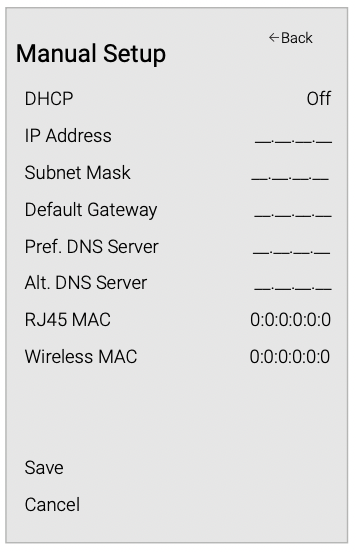
- From the NETWORK Menu, highlight Manual Setup and press OK. The MANUAL SETUP Menu is displayed.
- To change the settings manually, use the Arrow buttons on the remote to highlight DHCP and then use the Left/Right Arrow buttons to change the setting to Off.
- Use the Arrow and OK buttons to adjust each setting:
IP Address - The IP address assigned to the Display.
Subnet Mask - The subnet Exit 2D
Default Gateway - Your network’s default gateway address.
Pref. DNS Server - Your preferred domain name server address.
Alt. DNS Server - Your alternate domain name server address. - Use the Arrow buttons on the remote to highlight Save and press OK.
- Press the Exit button on the remote.
Finding MAC Addresses for Network Setup
The security settings on your router may require you to enter the Display’s MAC address in the router’s settings.
To find the Display’s MAC address:
- From the NETWORK Menu, highlight Manual Setup and press OK. The MANUAL SETUP Menu is displayed.
- Find the MAC address for the Display at the bottom of the list. The MAC addresses for the connections in use are displayed:
RJ45 MAC - The Ethernet or RJ45 MAC address may be needed to set up your network when you have connected the Display to your network when you have connected the Display to your network with an Ethernet (Cat 5) cable.
Wireless MAC - The Wireless (WiFi) MAC address may be needed to connect your Display to your network with WiFi.
Connecting to a Hidden Network
To connect to a wireless network whose network name (SSID) is not being broadcast:

- From the NETWORK Menu, highlight Hidden Network and press OK. The ENTER ACCESS POINT NAME screen is displayed.
- Using the on-screen keyboard, enter your network’s name (SSID), then highlight Connect and press OK
- Using the on-screen keyboard, enter your network’s password, then highlight Connect and press OK.
- Press the Exit button on the remote.
Testing Your Network Connection
To test your network connection:
- From the NETWORK Menu, highlight Test Connection and press OK.
- The TEST CONNECTION screen displays the connection method, network name, signal strength, and download speed of your network connection.
- Press the Exit button on the remote.
SETTING TIMERS
Setting the Sleep Timer
When activated, the Display’s sleep timer will turn the Display off after a set period of time.

- Press the Menu button on the remote. The on-screen Menu is displayed.
- Use the Arrow buttons on the remote to highlight Timers and press OK. The TIMERS Menu is displayed.
- Use the Left/Right Arrow buttons on the remote to highlight the period of time after which you want the Display to go to sleep: 30, 60, 90, 120, or 180 minutes. If you don’t want the sleep timer to activate, change the setting to Off.
- When you have finished setting the sleep timer, press the Exit button on the remote.
Setting the Auto Power Off Feature
To help save energy, your Display is set by default to turn off after 10 minutes without a video or audio signal. This feature can be deactivated.
To set the Auto Power Off feature:
- From the TIMERS Menu, use the Up/Down Arrow buttons on the remote to highlight Auto Power Off.
- Use the Left/Right Arrow buttons on the remote to change whether the Display will turn off. If you don’t want the Display to turn off when there is no signal, change the setting to Off. Otherwise, select 10 minutes.
- When you have finished setting the auto power off time, press the Exit button on the remote.
RENAMING DEVICES ON THE INPUT MENU
You can rename the Inputs to make them easier to recognize on the Input Menu. For example, if you have a DVD player connected to the Component Input, you can rename that Input to display “DVD Player.” See Changing the Input Source.
To change the name of an Input:

- Press the Menu button on the remote. The on-screen Menu is displayed.
- Use the Arrow buttons on the remote to highlight Input and press OK. The INPUT Menu is displayed.
- Highlight the Input device that you want to rename and press OK.
- To use a preset Input name:
a. Highlight the Input Port row and press Left/Right arrow keys to scroll across the list of preset names.
- or -
To enter a custom name:
a. Enter your custom label using the on-screen keyboard.
b. Highlight OK and press OK.
c. The Input Name changes to show the custom name that you created. - When you have finished naming your Input, press the Exit button on the remote.
CHANGING THE DISPLAY SETTINGS
Using the System menu, you can:
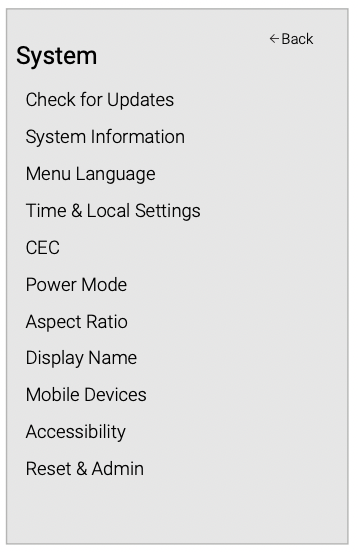
- Check for updates
- View system information
- Change the on-screen menu language
- Set time zone and local settings
- Adjust the CEC settings
- Adjust the Power Mode
- Adjust the aspect ratio
- Name the Display
- Review and maintain the list of paired devicess
- Adjust accessibility settings
- Reset the Display settings & set up administrative controls
Checking for System Updates
To view technical data and status information about your Display and network connection:
- Press the Menu button on the remote. The on-screen Menu is displayed.
- Use the Arrow buttons on the remote to highlight Check for Updates and press OK. The Display will begin to check for updates
- If an update is found, the Display will ask to confirm the update.
If no update is found the display will note No Update Available.
Viewing System Information
To view technical data and status information about your Display and network connection:
- Press the Menu button on the remote. The on-screen Menu is displayed.
- Use the Arrow buttons on the remote to highlight System Information and press OK. The SYSTEM Menu is displayed.
- Use the Up/Down Arrow buttons to scroll through the system information.
- When you are finished reviewing the system information, press the Exit button on the remote.
Setting the Time and Local Settings
To ensure the correct time is displayed when you press the INFO button, set the Display’s time zone:
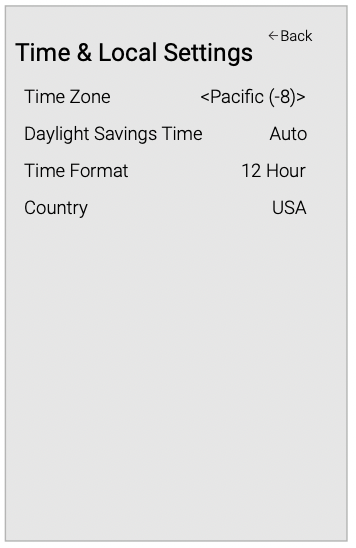
- Press the Menu button on the remote. The on-screen Menu is displayed.
- Use the Arrow buttons on the remote to highlight System and press OK. The SYSTEM Menu is displayed.
- Use the Arrow buttons on the remote to highlight Time & Local Settings and press OK. The Menu headed by the local date and time is displayed.
- Highlight Time Zone and press OK. The TIME ZONE Menu is displayed.
- Highlight your time zone and press OK.
- Highlight Daylight Saving Time and press OK. The DAYLIGHT SAVING TIME Menu is displayed. Choose On if it is currently Daylight Savings Time, Off if it is Standard Time, or Auto to have the system automatically detect Daylight Savings Settings.
- Press the Exit button on the remote.
Changing the On-Screen Menu Language
Your Display can display the on-screen Menu in different languages.
To change the on-screen Menu language:

- Press the Menu button on the remote. The on-screen Menu is displayed.
- Use the Arrow buttons on the remote to highlight System and press OK. The SYSTEM Menu is displayed.
- Use the Arrow buttons on the remote to highlight Menu Language and press OK. The MENU LANGUAGE Menu is displayed.
- Highlight your preferred language (English, Español, or Français) and press OK.
- Press the Exit button on the remote.
Adjusting the CEC Settings
The CEC function on your Display enables you to control HDMI-connected devices with the included remote without any additional programming.
WARNING: Not all HDMI devices support CEC. See your device’s user manual for details.
To enable, disable, or adjust CEC settings:
- Press the Menu button on the remote. The on-screen Menu is displayed.
- Use the Arrow buttons on the remote to highlight System and press OK. The SYSTEM Menu is displayed.
- Use the Arrow buttons on the remote to highlight CEC and press OK. The CEC Menu is displayed.
- Use the Arrow and OK buttons to adjust each setting:
CEC - Select Enable to use the Display remote to control CEC devices connected to HDMI. Select ARC Only for plug and play of an audio device connected to the HDMI ARC Input. The ARC setting does not support video devices connected to the audio device (Select Enable to enable support for these devices). Select Disable to turn CEC off.
Device Discovery - Use this function to determine if your device is connected and supports CEC. (Required for Enable option only.) - Press the Exit button on the remote.
Adjusting the Power Mode
Your Display is set to Eco Mode by default. When the Display is powered off, Eco Mode setting uses less than 0.5W of power. Quick Start Mode enables your Display to power on faster as well as automatically power on when casting content.
WARNING: Please note that by changing this setting the energy consumption required to operate this device will change.
To switch between Eco Mode and Quick Start Mode:
- Press the Menu button on the remote. The on-screen Menu is displayed.
- Use the Arrow buttons on the remote to highlight System and press OK. The SYSTEM Menu is displayed.
- Use the Arrow buttons on the remote to highlight Power Mode and press OK. The Power Mode Menu is displayed.
- Highlight either Eco Mode or Quick Start Mode and press OK to select.
Turning the Power Indicator On or Off
The Power Indicator on the front of your Display normally does not glow when the Display is on. You can change this setting if you prefer the light to be on.
To turn the Power Indicator Light On or Off:
- Press the Menu button on the remote. The on-screen Menu is displayed.
- Use the Arrow buttons on the remote to highlight System and press OK. The SYSTEM Menu is displayed.
- Highlight Power Indicator and press OK.
- Use the Up/Down Arrow buttons to select On or Off, then press OK.
Changing the Display Name
Naming your display helps to differentiate it from other cast devices you may have in your home
To view or edit your Display name:
- Press the Menu button on the remote. The on-screen Menu is displayed.
- Use the Arrow buttons on the remote to highlight System and press OK. The SYSTEM Menu is displayed.
- Use the Arrow buttons on the remote to highlight Display Name and press OK. The Display Name Menu is displayed.
- Enter your custom name using the on-screen keyboard.
- Press the Exit button on the remote.

Managing Mobile Devices
Your Display can be paired with multiple mobile devices so you can easily control your Display across multiple devices
To see a list of paired devices or unpair a device:
- Press the Menu button on the remote. The on-screen Menu is displayed.
- Use the Arrow buttons on the remote to highlight System and press OK. The SYSTEM Menu is displayed.
- Use the Arrow buttons on the remote to highlight Mobile Devices and press OK. The list of paired devices appears.
- Highlight a device name to delete it and press OK
- Use the Left/Right Arrows to select YES or NO when asked to confirm.
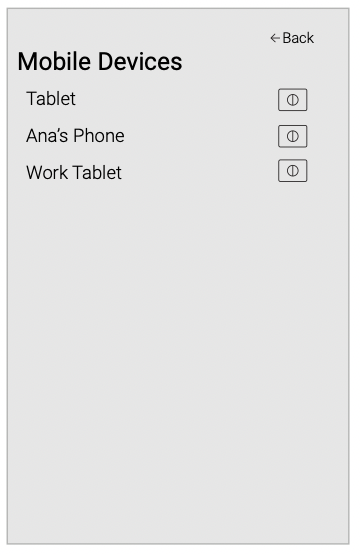
ACCESSIBILITY SETTINGS
VIZIO is committed to providing intuitive, user-friendly products. Your new VIZIO TV offers several accessibility features that can help you get the most out of it.
To access the Accessibility menu:
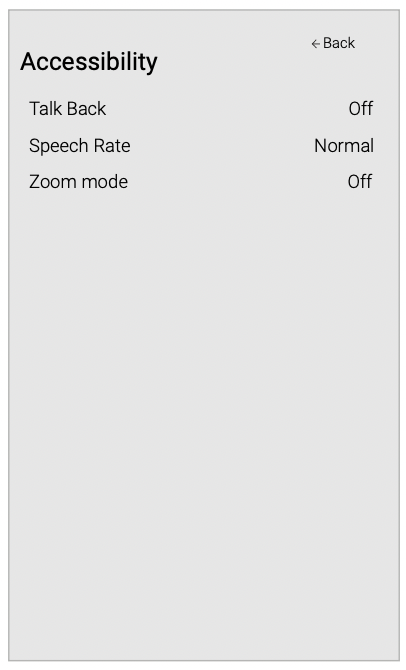
- Press the Menu button on the remote control.
- Use the Arrow and OK buttons to navigate and select System à Accessibility.
Talk Back* - Turn Text-to-Speech Talk Back On or Off. Text-to-Speech Talk Back enables your TV to speak all settings changes and adjustments using the remote in English.
Speech Rate - Adjusts the rate in which Text-to-Speech is spoken. Select Slow, Normal (Default), or Fast.
Zoom Mode - Enlarges a section of the screen by approximately 200%.
USING THE RESET & ADMIN MENU
You can use the Display’s Reset & Admin Menu to restore the Display to its factory default settings as well as access other system settings.
Using the Reset & Admin, you can:

- Reset the display to factory settings.
- Force the system to power off and on.
- Create a system pin code to lock content and picture settings.
- Turn On or Off Viewing Data
- Start or stop the Store Demo Mode.
Restoring the Display to Factory Default Settings
All of the on-screen Menu settings can be reset to the factory defaults.
WARNING: If you restore the Display to the factory default settings, all changes you have made to the settings will be lost! This includes any wireless or picture settings.
To restore the Display to its factory default settings:
- Press the Menu button on the remote. The on-screen Menu is displayed.
- Use the Arrow buttons on the remote to highlight System and press OK. The SYSTEM Menu is displayed.
- Highlight Reset & Admin and press OK. The RESET & ADMIN Menu is displayed.
- Highlight Reset Display to Factory Defaults and press OK. If you have set a SYSTEM PIN CODE, enter it now.
The Display displays, “Select Reset to restore all Display settings to factory defaults and clear all account information.” - Highlight Reset and press OK.
- Wait for the Display to turn off. The Display will turn Back on shortly afterward and the Setup App will begin.
USING THE INFO WINDOW
The Info Window can be displayed by pressing the Info button on the remote:
- Press the Info button one time to Display Name, Current Input, Picture Mode, Network Information, and Time.

HELP TOPICS
The remote is not responding.
- Make sure the batteries are properly inserted matching the - and + symbols.
- Replace the batteries with fresh ones.
There is no power.
- Ensure the Display is plugged into a working electrical outlet.
- Ensure the power cable is securely attached to the Display.
- Press the Power/Standby button on the remote or on the back of the Display to turn the Display on.
The power is on, but there is no image on the screen.
- Ensure all cables are securely attached to the Display.
- Ensure all devices are connected correctly. Devices differ; see your device’s user manual for details.
- Adjust Brightness, Contrast, or Backlight. See Adjusting the Picture Settings.
- Press the Input button on the remote to select a different Input source.
There is no sound.
- Press Volume Up on the remote control.
- Press the MUTE button on the remote to ensure mute is off.
- Check the audio settings. See Adjusting the Audio Settings.
- Check the audio connections of external devices (Blu-ray player, game console, cable/satellite box) that are connected to the Display.
The sound is flat or dialog is not audible.
- Turn off Volume Leveling. See Adjusting the Audio Settings.
The colors on the Display don’t look right.
- Adjust the Color and Tint settings in the Picture menu. See Adjusting the Picture Settings.
- Select a pre-set picture mode. See Adjusting the Picture Settings. VIZIO recommends selecting Calibrated.
- Check all cables to ensure they are securely attached.
The buttons on the remote aren’t working.
- Ensure you are only pressing one button at a time.
- Point the remote directly at the Display when pressing a button.
- Replace the remote batteries with new ones. See Replacing the Batteries.
The image quality is not good.
- For the best image quality, view high-definition programs using digital sources. Connect your devices with HDMI cables.
The picture is distorted.
- Move the Display away from electrical appliances, cars, and fluorescent lights.
- Ensure all cables are securely attached.
The display image does not cover the entire screen.
- If you are using Display, AV, or Component with 480i Input, press the
 button on the remote to change the screen mode.
button on the remote to change the screen mode.
The Display has pixels (dots) that are always dark.
- Your Display is precision-manufactured using an extremely high level of technology. However, sometimes pixels may not display correctly. These types of occurrences are inherent to this type of product and do not constitute a defective product.
I see “noise” or static on the screen.
- When your Display’s digital capabilities exceed a digital broadcast signal, the signal is up-converted (improved) to match your Display’s display capabilities. This up-converting can sometimes cause irregularities in the image.
When I change Input source, the display image changes size.
- The Display remembers the viewing mode on each Input source. If the viewing mode on the new Input source differs from the one on the Input source you switch from, the difference may be noticeable.
- See Changing the Screen Aspect Ratio..
How do I download the VIZIO SmartCast™ App?
- Make sure your phone or tablet is connected to a Wi-Fi network. Open a browser on your phone or tablet. Navigate to vizio.com/smartcastapp and follow the on-screen instructions to download the VIZIO SmartCast™ App.
How do I change the Inputs?
- Make sure the VIZIO SmartCast™ App is installed on your phone or tablet. Open the VIZIO SmartCast™ App. Tap on the Device list and select your Display. Tap on the Input lcon
 and select the Input of your choice.
and select the Input of your choice. - Press the Input button on the back of the Display to cycle through the Inputs.
- Press the Input button on the basic remote to cycle through the Inputs.
How do I connect to my Wi-Fi network?
- On your IR remote, press the Menu button then go to Network > Select your Wi-Fi name > Enter password.
- Press the Setup / Link button twice on the IR remote.
Open the VIZIO SmartCast™ App on your phone or tablet. Tap on the Device list and select Setup a New Device and follow the on-screen instructions. - Open the VIZIO SmartCast™ App on your phone or tablet.
Tap on the device list and select your Display. Tap on the Settings icon > Network > Wireless Access Points. Select your Wi-Fi network from the list, enter the Wi-Fi password, and tap Connect. - Press the Setup / Link button twice on the IR remote.
Press Play / Pause button to enter manual setup. Follow the on-screen instructions to complete setup and connect to a wireless network.
How do I stream apps like Netflix and Youtube to my VIZIO SmartCast™ Display?
- Download and open a Chromecast-enabled apps on your mobile device, such as like Netflix or Youtube. Then tap the Cast button.
How do I exit Demo Mode
- Press and hold the Input button on the back of the Display to exit the demo mode.
How do I watch Cable/Antenna TV channels?
- If you subscribe to cable or satellite, simply connect an HDMI cable (not included) to the receiver.
- If you use external antennas to watch local broadcast channels, a TV tuner is required and is sold separately by third parties.
